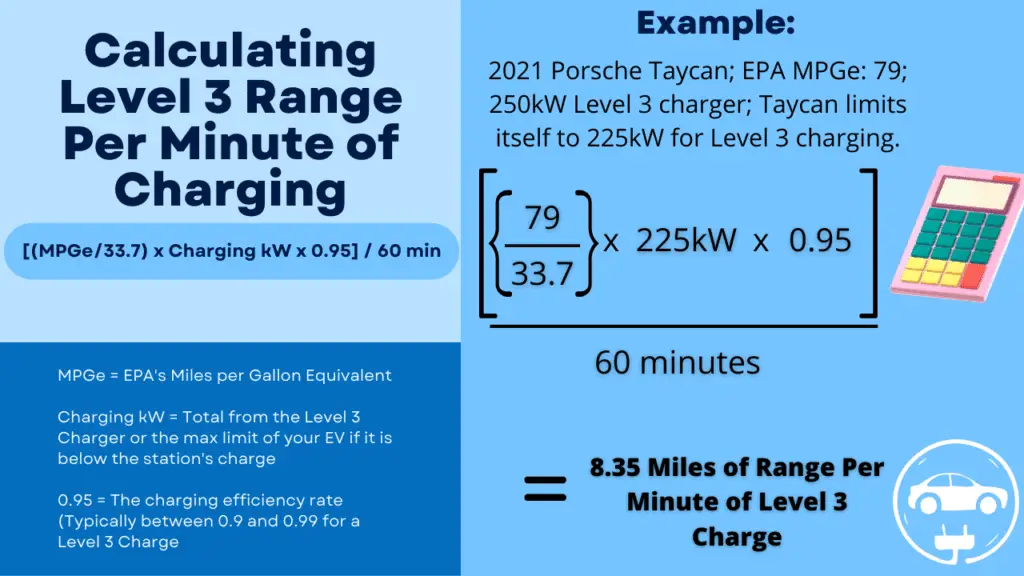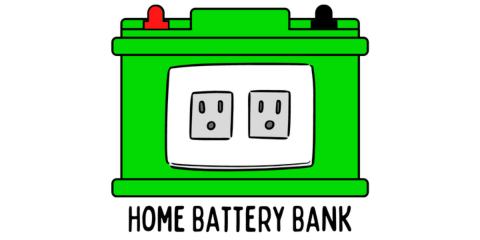Not all, but the majority of electric vehicles on the market today are capable of Level 3 Charging. Some call this “rapid charging”, “DC Fast Charging”, “fast charging”, etc.
This isn’t a charging process you do at your home, but rather at a charging station that you pay to use and are frequently located along major highways.
Whenever anyone researches EVs, one of the most common questions is what is the absolute fastest method to charge their car.
Level 3 charging is the fastest method of charging an electric vehicle and can recharge a battery up to 80% in 15-45 minutes. Level 3 charging takes place in commercial locations and supplies 50-350kw of direct current (DC) power directly to the battery and bypasses the EV’s limited onboard charger.
That’s the quick and easy summary if you’re just here for the Sparknotes. If you’ve got a few minutes I’ll show you the following:
- How Fast is Level 3 EV Charging
- How Much Power Does Level 3 Charging Supply
- How to Easily Calculate Level 3 Charge Times
- How Many Driving Miles per Minute are Gained with Level 3 Charging
Let’s get started!
How Fast is Level 3 EV Charging
Level 3 charging is the fastest method of charging and supplies 3-20 times more power than higher rates of Level 2 charging.
Level 1 charging can take 2-3 days for a full recharge. Level 2 charging can take 10-15 hours. Level 3 charging only takes 15-45 minutes for an 80% charge.
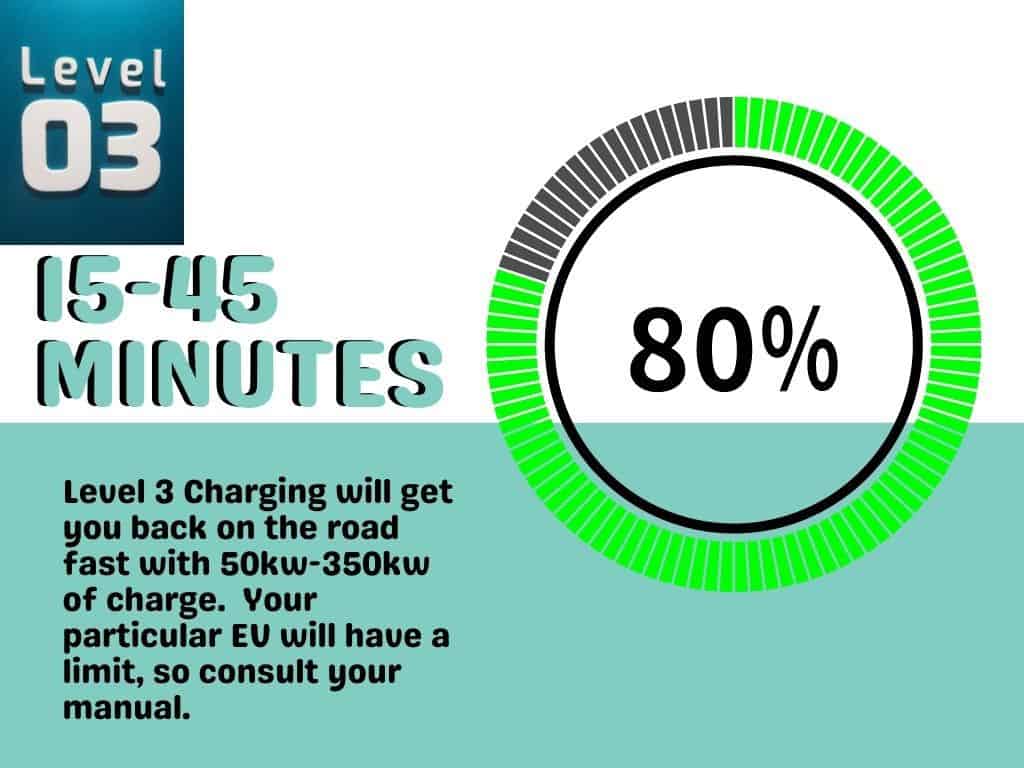
The reason Level 3 charging is only calculated up to 80% is because as the internal resistance of the battery builds up, the supply power must be dramatically reduced in order to prevent overheating and damage to the battery.
The high charging rates of Level 3 charging are readily accepted by the battery until the 80% mark. After that, the EV’s onboard computers will stop the process to severely throttle it.
Below is a table where I calculated the Level 3 charging times for the 11 top selling EVs in the last year.
There’s a couple things to keep in mind:
- Just because the EV takes longer to charge doesn’t mean that it is “worse” than the others, as some electric vehicles have much larger batteries and therefore more range
- All electric vehicles have a maximum kilowatt rate that they can accept when charging at Level 3 (as well as Level 2), so just because you bring your Nissan Leaf to a 350kw charger doesn’t mean it can accept that much
- The times below are in minutes, and not hours
| EV Model | Year | Net Battery Capacity (Usable) | Model’s Level 3 Charging Limit in Kilowatts | Level 3 Minutes from 0% to 80% charge at 50kw | Level 3 Minutes to 80% charge at 100kw | Level 3 Minutes to 80% charge at 250kw |
|---|---|---|---|---|---|---|
| Tesla Model Y | 2020 | 75 | 210 | 76 | 37 | *15 |
| Tesla Model 3 | 2020 | 57.5 | 250 | 58 | 19 | 12 |
| Ford Mustang Mach E | 2021 | 68 | 115 | 69 | 34 | *30 |
| Chevy Bolt EV | 2021 | 60 | 55 | 61 | *55 | *55 |
| Volkswagen ID.4 | 2021 | 77 | 125 | 78 | 39 | *31 |
| Nissan Leaf | 2021 | 37 | 46 | *40 | *40 | *40 |
| Audi e-tron | 2021 | 86 | 110 | 87 | 43 | *40 |
| Porsche Taycan | 2021 | 71 | 225 | 72 | 36 | *16 |
| Tesla Model S | 2020 | 95 | 200 | 96 | 48 | *24 |
| Hyundai Kona Electric | 2021 | 64 | 75 | 65 | *43 | *43 |
| Tesla Model X | 2020 | 95 | 200 | 96 | 48 | *24 |
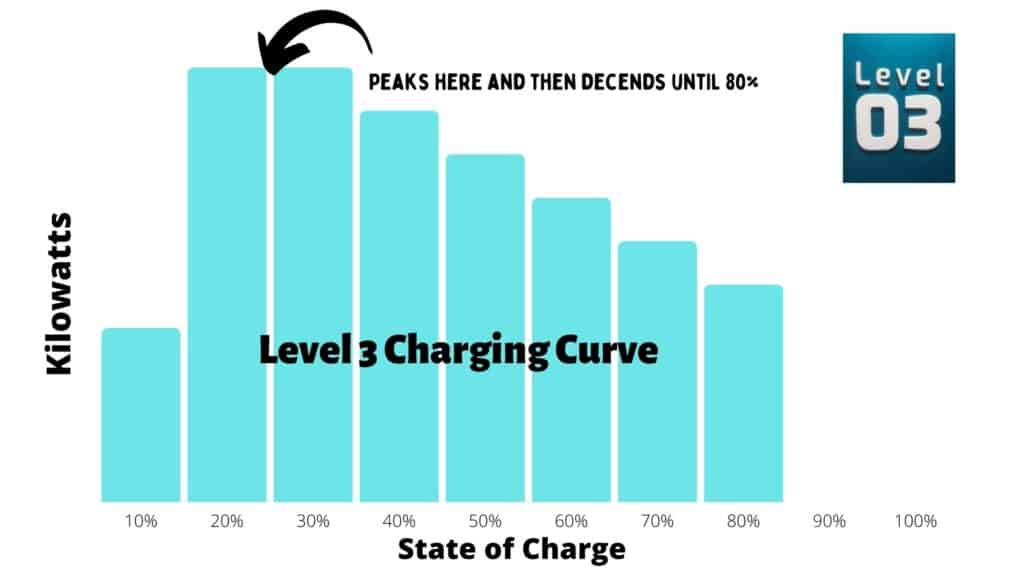
How Much Power Does Level 3 Charging Supply
The current range for Level 3 charging is from 50kW to 350kW, though most electric cars are presently not capable of charging at the 350kW rate and fall at 250kw or below.
Level 3 charging works with Direct Current (DC) and not Alternating Current (AC).
When you charge your vehicles at home with Level 1 or Level 2 charging, you are using AC power from your wall outlets. That electricity enters into the EV via the EVSE and the onboard charger converts that AC into DC electricity. That conversion process lowers charging efficiency.
DC fast charging, or Level 3, converts the AC power to DC at the station itself and the station itself is the charger. When you hook up the EVSE, the electricity flows directly into the battery and bypasses the onboard charger.
How to Easily Calculate Level 3 Charge Times
Calculating Level 3 charging times to get ballpark estimates is quite simple to do.
When determining how long it will take to charge an electric vehicle with Level 3 charging, you first need to figure out how many kWh (kilowatt hours) you need to replace in your EV’s battery.
Use the following steps to figure out how to determine how long it will take to charge your EV:
- Step 1: Find the net battery capacity of your vehicle (or usable portion of the battery for propulsion) using this website
- Step 2: Identify what state of charge (percentage) your battery is currently at
- Step 3: Add that number to 20 and subtract the total from 100 to get the percentage that needs to be charged (we only need to charge to 80%, so that’s where the number 20 came from because 20% of the battery won’t be affected)
- Step 4: Take the percentage calculated in Step 3 and multiply it by the net capacity of the EV battery
- Step 5: Take total kilowatts of the charging station (or the max that your car can accept if you’re at a station with higher kilowatts than your car can take) and multiply it by the efficiency factor (I generally use 0.95 for Level 3 charging)
- Step 6: Divide Step 4’s answer by Step 5’s answer.
- Step 7: Multiply the answer from Step 6 by 60 minutes to get the total time in minutes
Example:
Let’s say we want to charge a 2021 Ford Mustang Mach-E which has a 68kWh battery at a 150kW Level 3 charging station. The current state of charge of the battery is 15%.
- 15% + 20% = 35%
- 100% – 35% = 65%
- 68kWh x 0.65 = 44.2kWh that need to be recharged to reach 80% capacity
- 44.2kWh / 115kW = 0.38435 hours (115kW is the Level 3 charging limit of the Mach-E, so it cannot reach the full 150kW of the station)
- 0.38435 / 0.95 efficiency factor = 0.405 hours
- 0.405 x 60 minutes = 24 minutes
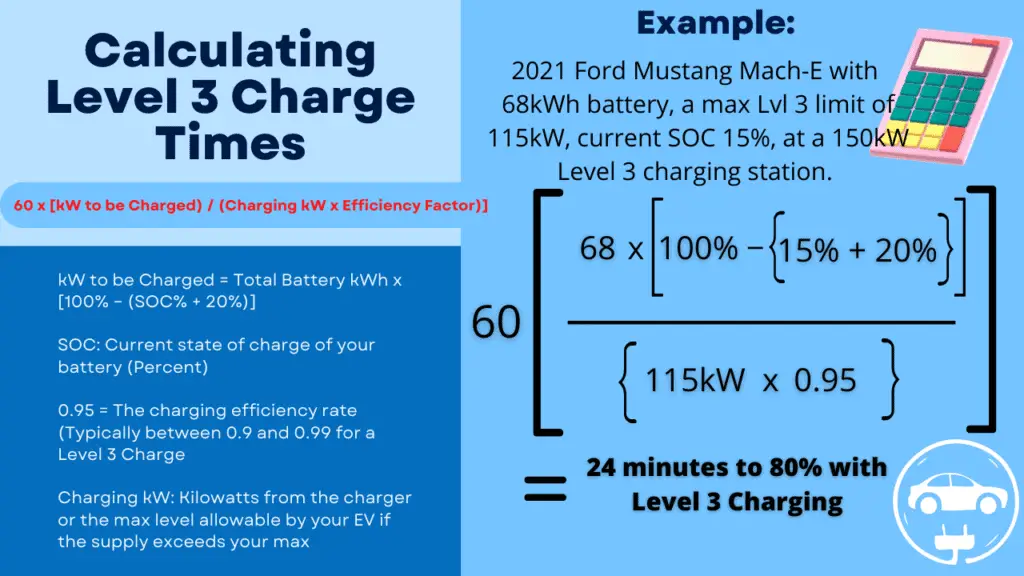
How Many Miles of Range are Gained per Minute of Level 3 Charging
A typical EV will easily gain 8-20+ miles of range per minute of Level 3 charging on average depending on the kilowatts supplied. The first third of the charging session will yield the highest results as the rate of absorption is highest by the battery at the start when its internal resistance is lower.
To calculate the miles of range that your EV will gain per minute of charging, just follow these steps:
- Step 1: Locate your EV’s MPGe from this website.
- Step 2: Divide the MPGe by 33.7
- Step 3: Multiply the answer in Step 2 by the kilowatts of the Level 3 charger (or what your car maxes out at if the charger is oversized)
- Step 4: Multiply the answer in Step 3 by an efficiency factor to get the theoretical miles gained per hour of charging (I use 0.95 for Level 3 charging)
- Step 5: Divide the answer in Step 4 by 60 minutes to get the average miles gained per minute of Level 3 charging
Example:
Let’s take the 2021 Porsche Taycan which has a combined EPA MPGe of 79 and pretend that we pull up to a 250kW Level 3 charger. The Taycan limits itself to 225kW for Level 3 charging.
- 79 MPGe / 33.7 = 2.344 Miles per kilowatt hour of battery charge
- 2.344 x 225kW x 0.95 Efficiency = 501.1
- 501.1 / 60 minutes = 8.35 average miles of driving range gained per minute of Level 3 charging
If we compare that to the standard range 2020 Tesla Model 3, which has a combined EPA MPGe of 131, a limit of 250kW, and we pull up the same charger, our results would look like the following:
- 131 / 33.7 = 3.89 Miles per kilowatt hour of battery charge
- 3.89 x 250kW x 0.95 Efficiency = 923.88
- 923.88 / 60 minutes = 15.4 average combined miles of driving range gained per minute of Level 3 Charging
